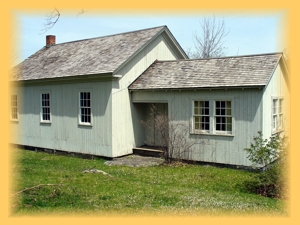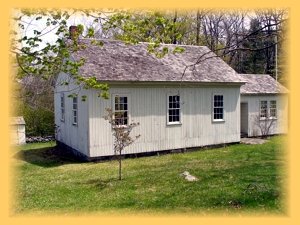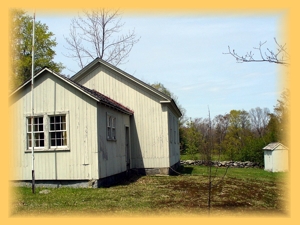|
In grateful
appreciation to:
Bob Grigg
Curator:
Colebrook Historical
Society
Municipal Historian:
Town of Colebrook,
County of Litchfield,
State of Connecticut, USA
"As Colebrook’s population
grew, the need for more districts became necessary, and on October 20, 1796,
a meeting of the inhabitants of Colebrook was called to form a School
Society."
 |
History of the Rock School
At the first town meeting
 held
in Colebrook, held on December 13, 1779, the voters authorized two
school districts – North and South. “The north is to go from the colony
(state) line south as far as Capt. Samuel Rockwell’s. The south consisting
of all Colebrook lands lying two miles north of the Winchester line.” held
in Colebrook, held on December 13, 1779, the voters authorized two
school districts – North and South. “The north is to go from the colony
(state) line south as far as Capt. Samuel Rockwell’s. The south consisting
of all Colebrook lands lying two miles north of the Winchester line.”
At
this meeting the voters directed that the listers (tax collectors) set up
notifications on the signpost and on the two schoolhouses.
As
Colebrook’s population grew, the need for more districts became necessary,
and on October 20, 1796, a meeting of the inhabitants of Colebrook was
called to form a School Society. Chosen was a moderator, chairman, treasurer
and a three-man school committee. The first vote taken by this body was to
appoint a committee to form several school districts.
Now, for the first time, the North School found itself in a named district –
the Sandisfield Road District. This district encompassed the area from the
Massachusetts border at the point where Viets Brook enters Colebrook, down
that brook to Sandy Brook, south along that brook to about where the Kitchel
cottage now stands, then westward over the hill to Colebrook Center
approximately where the Colebrook Consolidated School now stands, then
westerly along property lines to near where Loon Brook crosses Phelps Road,
up that brook to the Norfolk town line, then north along that line to the
Massachusetts line, and ending by going along the state line to Viets Brook.
District revision came in 1805 when the south part of the north district was
granted the right to set up a school. (Presumably this would be called the
Center District.) Revision again came in 1823 when all that part of the
North School District north of Capt. Arah Phelps’ was made a new school
district. Thus the original Sandisfield Road District was divided into three
parts with the schoolhouse now sitting in what was then called the North
Middle District. During the latter half of the 19th century, the
name, through popular usage, presumably, became simply the Rock School
District.
From the fall of 1779 until the fall of 1911, this building continuously
served Colebrook as a schoolhouse. Population declines forced the town to
cut back the number of schoolhouses, and thus we see the voters on October
26, 1911 abolishing the transportation routes for the Beech Hill and Rock
Districts. The remaining students were transferred to the Center School.
On
March 1, 1920, it was voted to sell the Rock and North schoolhouses. The
Rock Schoolhouse remained in private hands until 1970, when the then owner,
not having any plans for the building, and not wishing to pay taxes on it,
suggested that perhaps the Historical Society would like it as a museum, if
it could be moved to a new location.
Nancy Phelps Blum, long a mainstay of the Society, and whose ancestors had
attended the school since the 18th century, donated the corner of her
adjacent field, directly across the road from the school. After a successful
fund-raising campaign, the Rock School building was moved to its present
location on March 23, 1971, having remained in front of its namesake glacial
boulder for 191 years.
The
Colebrook Historical Society, upon deciding to make the school available to
school groups, elected to restore the classroom to that of the late 1850s.
Primarily this is due to the fact that there are individual seats and desks,
whereas in the 1700s, benches were built in as an integral part of the
building. The position of these benches can be seen today on the floor
patterns. In 1858, the year currently being chosen for the visiting
student’s yearly sojourn, the U. S. flag had 32 stars consisting of 5 rows
containing a pattern of 7-6-6-6-7.
It
is indeed fortunate that during the period when the schoolhouse was in
private hands, no modernization took place. It was only used as a summer
cottage, and the elderly owners didn’t feel the need for electricity, nor
did they object to using the “backhouse”. They continued to use the spring,
located just downhill from the schoolhouse that has been in documented use
since the early 1760s. The result is that this schoolhouse museum is, as far
as can be determined, the only colonial era school in Connecticut that has
never been modernized in any way; what the visitor today sees is essentially
exactly the same that students saw the first year Colebrook was a town. The
vast majority of the textbooks that are used by the students today are
original, as is the large 1829 wall map.
- Bob Grigg
View/Print PDF
Preparing for Rock School Day
Once a year, at the beginning of June,
the third grade pupils from the Colebrook Consolidated School spend an
entire school day at our schoolhouse/museum located at the intersection of
Colebrook Road and Sandy Brook Road. The building was erected during the
summer of 1779 and remained in use from that date until decreases in
population caused it to close in 1911.
The Colebrook Historical Society makes certain
that all aspects of the vintage school are as historically accurate as is
possible. For the most part, everything is in place and only needs the
teacher and her third graders to complete the picture. Minor adjustments do
need to be made occasionally, and a few years ago we tackled two of them.
One involved the flag. Up until now, we have always used a conventional 50
star flag with which the pupils conducted opening flag ceremonies, and which
flies over the school throughout the day. In the year 2000, Rock School Day
was held on June 14, which happens to be Flag Day. Because of the added
significance, a 32 star flag was constructed reflecting the year 1858, the
date being portrayed that year. The Society feels that any year from 1779
through 1911 would be historically appropriate. The type of desks that we
have, however, represent the mid-nineteenth century, thus the choice of
year. The 32 star flag was current from July 4th, 1858 until July 3rd, 1859.
It consisted of five rows of stars arranged with the top row of seven,
followed by three rows of six, and ending with another row of seven. Any
flag that has ever been authorized may be flown today. There is no such
thing as an obsolescent American flag. When a new state joins the Union
prior to July 4th, a new star is applied to the flag beginning on July 4th.
When the admission date is after July 4th, then its star is not added until
the following Independence Day.
 So much for flags; our second upgrade
concerned writing instruments. Up until 1858, with the advent of the first
successful steel-tipped pen, writing, at least with ink, involved the use of
wing feathers from crows, turkeys or other large birds. Thus we tell our
time-traveling students that when they grow up and have children of their
own, they will be able to tell them that theirs was the last American
generation that learned to write by using a quill pen. So much for flags; our second upgrade
concerned writing instruments. Up until 1858, with the advent of the first
successful steel-tipped pen, writing, at least with ink, involved the use of
wing feathers from crows, turkeys or other large birds. Thus we tell our
time-traveling students that when they grow up and have children of their
own, they will be able to tell them that theirs was the last American
generation that learned to write by using a quill pen.
You might well ask what’s the big deal about
quill pens; how difficult would it be to get a large feather, sharpen it,
dip it into ink, and start writing? Long ago, that’s what I thought. I
attempted to do some research on the subject, only to discover that if
anyone had ever written one word about how to go about creating a writing
instrument from a feather, I certainly couldn’t find it!
My first attempt was to make the tip look the
same as a steel nib – in other words, having a long taper with a slit in the
center. It didn’t work, not even close. Finally I gave up for a while, only
to be involved again when a friend shot a wild turkey, from whom I begged
the wings. I needed quite a few feathers to hone my skills. Here is what was
discovered: There are several types of feathers that can be made into
writing tools. The length isn’t all that important, although you don’t want
the largest. The shortest may be as short as four inches, especially when
you consider that we were making pens for nine year olds. What is essential
is that only feathers having a transparent end be used; those having a
milk-white, or dark tip won’t work because they seem to be too soft, drag on
the surface of the paper, and don’t evenly distribute the ink. Neither do
they need a split to facilitate the flow of ink. The point can be fairly
blunt. The top of the point is determined by holding the feather so that it
fits your hand comfortably. When this is accomplished, make a mark at the
top of the stem of the feather. Turn it over and cut at about a forty-five
degree angle (a single edged razor works best for me). Remove the small,
transparent disks that you will find inside the stem, dip into ink, dragging
the tip along the edge of the ink well, and write! You will no doubt need to
make a few adjustments, but from here on, you are basically finished. There
is one more item that you will need, and as far as I’ve been able to find
out, you will have to make your own. We’re talking about an ink blotter.
These were easy enough to come by a few years ago, but they are as hard to
find today as hen’s teeth! I have settled on pieces of the thickest paper
toweling, which does a credible job as long as you are careful not to smudge
the ink.
I’m not certain our 3rd graders will fully
appreciate the technology employed in writing the Declaration of
Independence, but I certainly do!
- Bob Grigg
View/Print PDF
- Back to
Index -
|
|